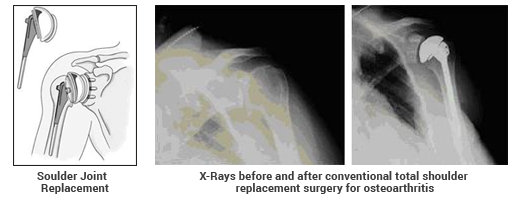-
Mon - Sat
08:00am - 08:00pm


Over the years, Shoulder replacement surgery has come to be used for many other painful conditions of the shoulder. These include:
The shoulder is a ball-and-socket joint that enables you to raise, twist and bend your arm. It also lets you move your arm forward, to the side and behind you. In a normal shoulder, the rounded end of the upper arm bone (head of the humerus) glides against the small dish-like socket (glenoid) in the shoulder blade (scapula). These joint surfaces are normally covered with smooth cartilage. They allow the shoulder to rotate through a greater range of motion than any other joint in the body.
The surrounding muscles and tendons provide stability and support. Unfortunately, conditions like those listed above can lead to loss of the cartilage and mechanical deterioration of the shoulder joint. The result can be pain. You can have a stiff shoulder that grinds or clunks. This can lead to a loss of strength, decreased range of motion in the shoulder and impaired function. X-rays of the shoulder would show:
In severe cases, bone-on-bone arthritis may lead to erosion–wearing away of the bone.
Deep ache, pain mainly at night, grinding or clumps while moving the shoulder, feeling of catch, grab or lock up. Loss of ROM, simple daily activities like reaching into a cupboard, dressing, toileting and washing the opposite armpit may become increasingly difficult.
Treatment of an arthritic shoulder starts with rest, exercise and taking arthritis medications. Resting the shoulder and applying moist heat can ease mild pain. After strenuous activity, an ice pack may be more effective at decreasing pain and swelling.
Physical therapy may be helpful when arthritis is in early stages. It helps maintain joint motion and strengthen the shoulder muscles.
If nonoperative treatments fail, shoulder replacement surgery may be needed. Shoulder replacements are usually done to relieve pain.
There are several different types of shoulder replacements.
The usual total shoulder replacement involves replacing the arthritic joint surfaces with a highly polished metal ball attached to a stem, and a plastic socket.
Depending on the condition of the shoulder, your surgeon may replace only the ball. Sometimes, this decision is made in the operating room at the time of the surgery. Some surgeons replace the ball when it is severely fractured and the socket is normal.
When both ball and the cup are badly effected but the shoulder has good muscles all around than the choice of anatomical total shoulder replacement is appropriate.
Another type of shoulder replacement is called reverse total shoulder replacement. Reverse total shoulder replacement is used for people who have:
Completely torn rotator cuffs that is the muscles with in shoulder complex and Severely osteoarthritis of shoulder (cuff tear arthropathy) or a case of a previous shoulder replacement that failed.
For these individuals, a conventional total shoulder replacement can still leave them with pain. They may also be unable to lift their arm up past a 90-degree angle. Not being able to lift one’s arm away from the side can be severely debilitating. In reverse total shoulder replacement, the socket and metal ball are switched. That means a metal ball is attached to the shoulder bone and a plastic socket is attached to the upper arm bone. This allows the patient to use the deltoid muscle instead of the torn rotator cuff to lift the arm.
Shoulder replacement surgery is highly technical. It should be performed by a surgical team with experience in this procedure. Each case is individual. Your surgeon will evaluate your situation carefully before making any decisions. Do not hesitate to ask what type of implant will be used in your situation. Ask why that choice is right for you.
Before surgery, patients see their anesthetist and general physician for a preoperative medical evaluation. Cardiac patients should see their cardiologist as well. Two weeks before surgery, you should stop taking the following medications that thin the blood and can lead to excessive bleeding during surgery:
The surgery is performed on an inpatient basis. The surgeon removes a part of shoulder ball and place a smooth shiny artificial ball that get fixed to the arm bone. The cup is similarly shaved off and a plastic shallow cup is cemented.

A careful, well-planned rehabilitation program is critical to the success of a shoulder replacement. You usually start gentle physical therapy on the first day after the operation. You wear an arm sling during the day for the first several weeks after surgery. You wear the sling at night for 4 to 6 weeks. Most patients are able to perform simple activities such as eating, dressing and grooming within 2 weeks after surgery. Driving a car is not allowed for 6 weeks after surgery.
Here are some “do’s and don’ts” for when you return home:
Generally, patients have such limitation of movement and pain pre op that a very substantial relief in pain is observed.
Range of movement also improves to the level that patient is able to perform all activity of daily living without problem.
Over all very gratifying pain relief.
